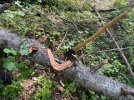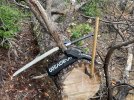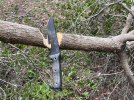- Joined
- May 29, 2004
- Messages
- 3,028
Hi folks!
As these prototypes get closer to being finished I wanted to share some thoughts about design, materials, and some philosophy.
I was lucky enough to find a career that catered to my enjoyment of using “outdoor” knives - my favorite “class” of knife.
This was especially true after I transferred from the Santa Cruz coast to the San Mateo coast several years ago, where clearing blocked trails and roads became part of my regular duties.



At that point, I was able to try out axes, saws, and a wide variety of high performance fixed blades on green and seasoned trees and bushes that fell in and around Butano State Park.




Along with many years of backpacking, these experiences have helped me form my own thoughts and preferences about outdoor knives.
Primary among these is that I want the most possible utility from my knives.
There are a few factors that I take into consideration:
Weight: Using relatively thin steel stock thickness, lightweight handle materials and stock reduction techniques (e.g. tapered tangs and skeletonized handles) keep weight to a minimum for knives at a particular size. This tends to increase cutting/chopping performance as well.
Reliability: I expect an outdoor knife to perform the role of a “survival knife”, and so I value durability and toughness over abrasive edge retention. Therefore I choose relatively tough steels, tempered to favor toughness.
Defensive qualities: I also expect an outdoor knife to perform the role of a defensive knife if necessary, and therefore I feel that two aspects are important here - an acute point profile and a substantial guard/finger stop. Trailing points and flat spine profiles also favor the back-cut, and will be found on most of my designs.
More to come. Hope everyone has some extra time off this week to enjoy themselves.
As these prototypes get closer to being finished I wanted to share some thoughts about design, materials, and some philosophy.
I was lucky enough to find a career that catered to my enjoyment of using “outdoor” knives - my favorite “class” of knife.
This was especially true after I transferred from the Santa Cruz coast to the San Mateo coast several years ago, where clearing blocked trails and roads became part of my regular duties.



At that point, I was able to try out axes, saws, and a wide variety of high performance fixed blades on green and seasoned trees and bushes that fell in and around Butano State Park.




Along with many years of backpacking, these experiences have helped me form my own thoughts and preferences about outdoor knives.
Primary among these is that I want the most possible utility from my knives.
There are a few factors that I take into consideration:
Weight: Using relatively thin steel stock thickness, lightweight handle materials and stock reduction techniques (e.g. tapered tangs and skeletonized handles) keep weight to a minimum for knives at a particular size. This tends to increase cutting/chopping performance as well.
Reliability: I expect an outdoor knife to perform the role of a “survival knife”, and so I value durability and toughness over abrasive edge retention. Therefore I choose relatively tough steels, tempered to favor toughness.
Defensive qualities: I also expect an outdoor knife to perform the role of a defensive knife if necessary, and therefore I feel that two aspects are important here - an acute point profile and a substantial guard/finger stop. Trailing points and flat spine profiles also favor the back-cut, and will be found on most of my designs.
More to come. Hope everyone has some extra time off this week to enjoy themselves.
Last edited:
